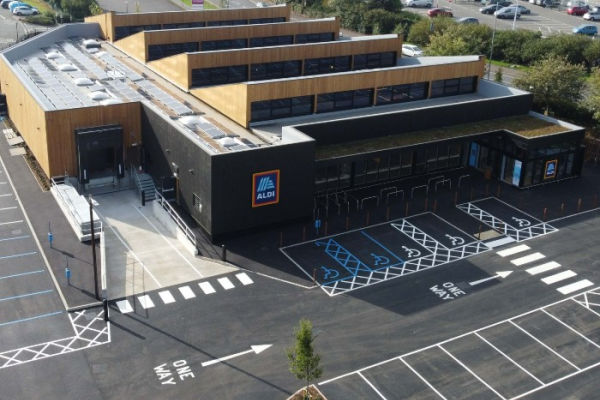Retailers have been battling against soaring costs in recent years with skyrocketing energy prices eating into profits.
M&S, Pets at Home and B&Q owner Kingfisher are among a few that have been forced to adjust its profit guidance at some point in the last year as a result of climbing energy costs.
Over the past year, the government has heavily subsidised energy bills through capping wholesale prices, which has provided the industry with some short-lived relief.
However, this is set to change come 1 April when the government scales back its support replacing the current scheme with a discount.
This move has one in five retailers fearing for their survival over the next 12 months with 60% of retailers citing energy costs as the biggest margin pressures, according to FRP Advisory.
Retail Gazette takes a look at how retailers have been tackling rising energy costs and where the switch in government support leaves the industry.
Moving to a new scheme
The government’s current energy price cap scheme will finish this week after Chancellor Jeremy Hunt concluded the support was “unsustainably expensive” having racked up £18.4bn in costs over six months.
The support, which set a limit on how much energy suppliers can charge, has “significantly lowered bills” for retailers and in some cases“cut them in half”, says EY partner Mats Persson.
From 1 April, the government will introduce its less generous Energy Bill Discount Scheme (EBDS) providing general businesses a discount when electricity and gas prices hit 302 £/MWh and 107 £/MWh.
“The scheme will offer very little protection to any business looking to recontract at the moment because it’s set at a level that is above the current wholesale prices,” says PwC utilities director Ronan O’Regan.
Wholesale energy prices as of 28 March sit at 130 £/MWH, lower than the EBDS catchment price. However, it is still higher than the average price five years ago.
“The bottom line is [the new scheme] is like an insurance policy,” he says, pointing out that even if wholesale prices were to rise and trigger the protection, the level of support would still be “pretty minimal”.
Persson echoes O’Regan’s sentiment adding that “retailer’s won’t feel much difference but they will in the autumn and winter when prices rise”.
This will add further pressure onto retailers that are already struggling with mounting costs.
The Association of Convenience stores (ACS) warned almost 7,000 independently owned stores could be at risk of closure due to climbing energy bills.
Rising energy costs
Soaring bills have undoubtedly disrupted the retail industry forcing some to revise their growth plans and cost base in the hopes of protecting profit margins.
Iceland was forced to halt opening its planned new stores after its bill surged by £20m in the first quarter.

Meanwhile, B&Q owner Kingfisher swung to a £20m loss in the 12 months to 31 January as it battled against rising costs and softening demand for DIY goods.
The group’s operating costs edged up 2.4% driven by higher charges associated with some of this down to its “significantly higher” energy bills.
O’Regan explains that rocketing costs have come as a result of energy contracts coming to an end and renegotiated during periods of higher prices.
“The businesses which have been most impacted are those whose contracts have run out over the last 18 months or so. Those businesses would have been exposed to quite significant price increases,” he says.
As such, some have opted to secure short term contracts to cover the business through the winter with the ability to negotiate at lower rates in the spring when prices drop, he adds.
Wickes warned in October its cost base could be hit by an additional £7.5m bill “if energy prices were to remain at the current price cap for businesses” when its contract came up for renewal this month.
Meanwhile, M&S forecasted its energy bills were set to rise £100m this year on top of the £40m increase that ate into last year’s profits.
Cutting back costs
In a bid to curb rising bills, retailers have made several efforts towards reducing their energy usage, including replacing old systems and outdated technology with new, more efficient versions.
The Co-op trialled dimmer lighting in around 500 locations of its 2,500 convenience store network across the UK and is estimated to have reduced its electricity bills by up to £4,000 a year for a single store.
Halfords, Currys and LVMH have followed suit by reducing lighting in stores as well.

“Lighting is considered a quick win for many retailers when looking to reduce their energy costs,” explains Mark Shortland, managing director of lighting specialist Shoplight.
“A lighting scheme can be changed in a night or two, often delivering energy savings of around 60% compared to old technology,” he says.
Cotswold Outdoor has had lighting refits in about 50 of its UK stores and Claire’s Accessories has had new lighting installed in over 600 stores across the UK and Europe in an effort to drive down its energy costs.
Shortland says that rising costs has seen more of a “desire [from retailers] to want to understand the energy implications of a lighting scheme for new stores as well as refits nowadays”.
“Of course, retailers continue to look for the best value from their suppliers but there is also a growing demand to understand the environmental impact of a product, which is encouraging retailers to not only look at the lowest possible price.”
John Lewis Partnership’s pursuit to reduce costs has accelerated its net zero emissions by 2035 strategy.

Waitrose has invested in more efficient refrigeration systems and replaced its gas heating with new pumps.
It is also in the midst of rolling out ‘air door’ technology to lessen the hot and cold air infiltration into a building.
Similarly, Iceland has cut back on the number of chilled items it sells to reduce its fridge capacity.
However, FRP Advisory partner Phil Reynolds says “managing the impact of energy prices isn’t just a case of using less energy themselves. It requires a full appraisal of their entire operation and the pressures being faced by even the suppliers of their suppliers”.
Switching to renewable energy
Retailers have also been reviewing their energy source to trim down costs including reviewing its current energy agreement as well as installing solar panels for on-site generation, says Persson.
Earlier this month, Iceland signed a 10-year deal with Octopus Energy that will see 150 of its stores directly supplied by solar power from the Breach solar farm in Cambridgeshire.
Iceland chief executive Tersem Dhaliwal said the agreement would give the retailer “some clarity on its energy costs for the coming years, at a significant discount to the current wholesale price”.
“This helps us to mitigate the impact of the volatility that has plagued the industry for the past 12 months.”
Iceland managing director Richard Walker said in January he expects Iceland’s energy bill to reduce this year as the supermarket looked to be as “energy efficient as possible”.
He said: “We expect our fuel bill to be less this year. The price of energy is still uncomfortably high, and much higher than it was before Ukraine, but at least now we can plan.
John Lewis Partnership also signed a power purchase agreement for renewable energy in 2020 to account for a significant proportion of its energy usage.

The cost of renewable energy is a lot lower than wholesale energy prices which is why it is garnering a lot of interest from businesses, says O’Regan.
Most of the big grocers including Aldi, Co-op, Iceland, Lidl, Morrisons and Tesco have all installed solar panels on a number of stores for on-site generation.
“If you are a supermarket and you have space to put solar panels on, all of the electricity that comes from those solar panels to go into your store, you avoid having to pay all of the network charges to take electricity off the grid. It’s very advantageous at the moment,” O’Regan says.
Who shoulders the bill?
Rising operating costs in recent years has squeezed retailers’ margins pushing many to implement aggressive cost mitigation programmes.
“Margin erosion is possibly the single biggest challenge for retailers right now,” says Persson.
Retailers could start to pass on some of those cost rises on to the consumers via product price rises.

However, Persson says the cost pass-through chain is becoming “significantly more difficult” given the cost-of-living crisis.
“The divergence between inflation the consumer is facing and inflation the business is facing will become worse and more difficult to manage,” he says.
If retail inflation becomes significantly higher than consumer inflation, it becomes more difficult to pass the price on, notes Persson.
As such, he says “retailers will have to think about how to absorb the cost and find a way to avoid cost being passed through to suppliers”.
Where does this leave the industry?
This week’s changes to the government support on energy bills for businesses will leave the retail sector with little to no support forcing the industry to fend for itself against climbing costs.
However, aware that the support was only introduced as a temporary measure, many retailers have been racing to drive efficiency across their businesses in a bid to cut down energy bills.
The year ahead will place a spotlight on the retail industry, and those that have yet to get a handle on their energy bills will be at risk of slipping further behind.
Click here to sign up to Retail Gazette‘s free daily email newsletter


















